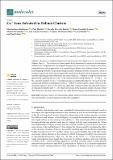Por favor, use este identificador para citar o enlazar a este item:
http://hdl.handle.net/10261/249817COMPARTIR / EXPORTAR:
 SHARE SHARE
 CORE
BASE CORE
BASE
|
|
| Visualizar otros formatos: MARC | Dublin Core | RDF | ORE | MODS | METS | DIDL | DATACITE | |

| Campo DC | Valor | Lengua/Idioma |
|---|---|---|
| dc.contributor.author | Bartolomei, Massimiliano | es_ES |
| dc.contributor.author | Martini, Paul | es_ES |
| dc.contributor.author | Pérez de Tudela, Ricardo | es_ES |
| dc.contributor.author | González-Lezana, Tomás | es_ES |
| dc.contributor.author | Hernández, Marta I. | es_ES |
| dc.contributor.author | Campos-Martínez, José | es_ES |
| dc.contributor.author | Hernández-Rojas, Javier | es_ES |
| dc.contributor.author | Bretón, José | es_ES |
| dc.contributor.author | Scheier, Paul | es_ES |
| dc.date.accessioned | 2021-09-09T10:22:28Z | - |
| dc.date.available | 2021-09-09T10:22:28Z | - |
| dc.date.issued | 2021-06-15 | - |
| dc.identifier.citation | Molecules 26(12): 3642 (2021) | es_ES |
| dc.identifier.issn | 1420-3049 | - |
| dc.identifier.uri | http://hdl.handle.net/10261/249817 | - |
| dc.description | 13 pags., 6 figs. -- This article belongs to the Special Issue Intermolecular Forces: From Atoms and Molecules to Nanostructures | es_ES |
| dc.description.abstract | We present a combined experimental and theoretical investigation on Ca+ ions in helium droplets, HeNCa+. The clusters have been formed in the laboratory by means of electron-impact ionization of Ca-doped helium nanodroplets. Energies and structures of such complexes have been computed using various approaches such as path integral Monte Carlo, diffusion Monte Carlo and basin-hopping methods. The potential energy functions employed in these calculations consist of analytical expressions following an improved Lennard-Jones formula whose parameters are finetuned by exploiting ab initio estimations. Ion yields of HeNCa+ -obtained via high-resolution mass spectrometry- generally decrease with N with a more pronounced drop between N = 17 and N = 25, the computed quantum HeNCa+ evaporation energies resembling this behavior. The analysis of the energies and structures reveals that covering Ca+ with 17 He atoms leads to a cluster with one of the smallest energies per atom. As new atoms are added, they continue to fill the first shell at the expense of reducing its stability, until N = 25, which corresponds to the maximum number of atoms in that shell. Behavior of the evaporation energies and radial densities suggests liquid-like cluster structures | es_ES |
| dc.description.sponsorship | This research was funded by the Austrian Science Fund FWF project number P31149 (P.M., P.S.) and the Spanish MICINN with Grants FIS2016-79596-P and PID2019-105225GB-I00 (J.B., J.H.-R.), FIS2017-83157-P (T.G.-L.) and FIS2017-84391-C2-2-P (M.B., J.C.-M., M.I.H.). | es_ES |
| dc.language.iso | eng | es_ES |
| dc.publisher | Multidisciplinary Digital Publishing Institute | es_ES |
| dc.relation | info:eu-repo/grantAgreement/MINECO/Plan Estatal de Investigación Científica y Técnica y de Innovación 2013-2016/FIS2016-79596-P | es_ES |
| dc.relation | info:eu-repo/grantAgreement/AEI/Plan Estatal de Investigación Científica y Técnica y de Innovación 2017-2020/FIS2017-83157-P | es_ES |
| dc.relation | info:eu-repo/grantAgreement/AEI/Plan Estatal de Investigación Científica y Técnica y de Innovación 2017-2020/PID2019-105225GB-I00 | es_ES |
| dc.relation | info:eu-repo/grantAgreement/AEI/Plan Estatal de Investigación Científica y Técnica y de Innovación 2017-2020/FIS2017-84391-C2-2-P | es_ES |
| dc.relation.isversionof | Publisher's version | es_ES |
| dc.rights | openAccess | es_ES |
| dc.subject | Molecular clusters | es_ES |
| dc.subject | Solvation | es_ES |
| dc.subject | Helium-alkaline earth ion interactions | es_ES |
| dc.subject | Helium nanodroplets | es_ES |
| dc.subject | Mass spectrometry | es_ES |
| dc.subject | Classical/quantum monte carlo calculations | es_ES |
| dc.title | Ca+ Ions Solvated in Helium Clusters | es_ES |
| dc.type | artículo | es_ES |
| dc.identifier.doi | 10.3390/molecules26123642 | - |
| dc.description.peerreviewed | Peer reviewed | es_ES |
| dc.relation.publisherversion | https://doi.org/10.3390/molecules26123642 | es_ES |
| dc.rights.license | https://creativecommons.org/licenses/by/4.0/ | es_ES |
| dc.contributor.funder | Austrian Science Fund | es_ES |
| dc.contributor.funder | Ministerio de Economía y Competitividad (España) | es_ES |
| dc.contributor.funder | Ministerio de Ciencia, Innovación y Universidades (España) | es_ES |
| dc.relation.csic | Sí | es_ES |
| oprm.item.hasRevision | no ko 0 false | * |
| dc.identifier.funder | http://dx.doi.org/10.13039/501100003329 | es_ES |
| dc.identifier.funder | http://dx.doi.org/10.13039/501100002428 | es_ES |
| dc.identifier.pmid | 34203679 | - |
| dc.type.coar | http://purl.org/coar/resource_type/c_6501 | es_ES |
| item.openairetype | artículo | - |
| item.languageiso639-1 | en | - |
| item.cerifentitytype | Publications | - |
| item.grantfulltext | open | - |
| item.fulltext | With Fulltext | - |
| item.openairecristype | http://purl.org/coar/resource_type/c_18cf | - |
| Aparece en las colecciones: | (CFMAC-IFF) Artículos | |
Ficheros en este ítem:
| Fichero | Descripción | Tamaño | Formato | |
|---|---|---|---|---|
| molecules-26-03642.pdf | Artículo principal | 892,26 kB | Adobe PDF |  Visualizar/Abrir |
| molecules-26-03642-s001.zip | Supplementary information | 697,16 kB | Unknown | Visualizar/Abrir |
CORE Recommender
PubMed Central
Citations
2
checked on 13-may-2024
SCOPUSTM
Citations
5
checked on 22-may-2024
WEB OF SCIENCETM
Citations
5
checked on 29-feb-2024
Page view(s)
83
checked on 22-may-2024
Download(s)
68
checked on 22-may-2024

